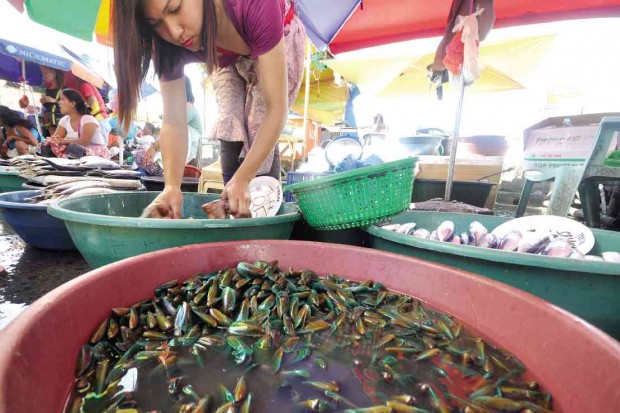Full impact of drought seen to spare Central Luzon

MUSSELS sell quickly at Dagupan City Fish Market. Another type of mussels has perished in Pangasinan riverbeds due to extreme heat. WILLIE LOMIBAO/INQUIRER NORTHERN LUZON
CITY OF SAN FERNANDO—Agriculture officials have good and bad news for farmers in Central Luzon.
First the good news. Central Luzon may be spared from the full impact of a dry spell brought by El Niño.
The bad news. Farmers would still have to prepare for the worst.
Typhoons “Lando” (international name: Koppu) and “Nona” (international name: Melor) last year brought sufficient amounts of rain to the Pantabangan and the Angat-Maasim Rivers Irrigation System dams, which supply irrigation water to majority of Central Luzon farms, according to Andrew Villacorta, Central Luzon director of the Department of Agriculture (DA).
He spoke to officers and members of 90 irrigators’ associations in Pampanga at an El Niño summit held on March 1 at the Bren Guiao Convention Center.
Article continues after this advertisementHe said farms covered by Angat Dam now have sufficient irrigation. Pantabangan, he said, is able to supply water to 104,000 out of 114,000 hectares of farms in Nueva Ecija province. The rest of the 10,000 hectares of farms in Nueva Ecija would get water through shallow tube wells, said Villacorta.
Article continues after this advertisementThe Pampanga provincial government sought to assure farmers that irrigation water would be available even if drought hits the province.
Villacorta said the local government is closely working with the DA in determining areas which would need more help in coping with the drought.
Last year’s dry spell did not leave significant damage to Pampanga farms, he said. This year, 236,000 out of 345,000 ha have already been planted, he said.
He said the DA has introduced alternative crops, which require less water, to farmers in areas that are expected to suffer most from the drought.
He said 1,600 kilograms of peanut seeds have been distributed and are now planted in 12.3 ha of farms; 11,097 kg of mung bean seeds in 554 ha; and 554 bags of corn seeds in
277 ha.
The government also built or rehabilitated diversion dams in the Pampanga towns of Floridablanca (spanning 55 ha), Porac (12 ha) and Arayat (15 ha).
“We’re expecting El Niño right now in the first quarter (of the year) but we’ve seen that it’s not that hot and it even rained last night,” Villacorta said.
In Pangasinan province, extreme heat has killed beds of mussels at the bottom of the Kakiputan Channel separating Bolinao town and the island town of Anda.
But Westly Rosario, chief of the National Integrated Fisheries Technology Development Center in Dagupan City, said the dead mussels are not the green-lipped mussel (Perna viridis) variety sold in public markets.
“The dead mussels are the charru or blue mussels (Mytella charruana), which were found thriving in the Pantal River in Dagupan City two years ago,” he said.
He said the blue mussels, which used to be found only in Central and South American countries, were also found in the Kakiputan Channel and in waters off the provinces of Bataan and Cavite.
Rosario said the edible blue mussels died because of the high salinity of water in the channel due to the heat. Mussels are environment-friendly creatures because they help clean the river by filtering the water. Rosario said each mussel filters 2 to 5 liters of water per hour. Reports from Justine Dizon, Inquirer Central Luzon, and Gabriel Cardinoza, Inquirer Northern Luzon